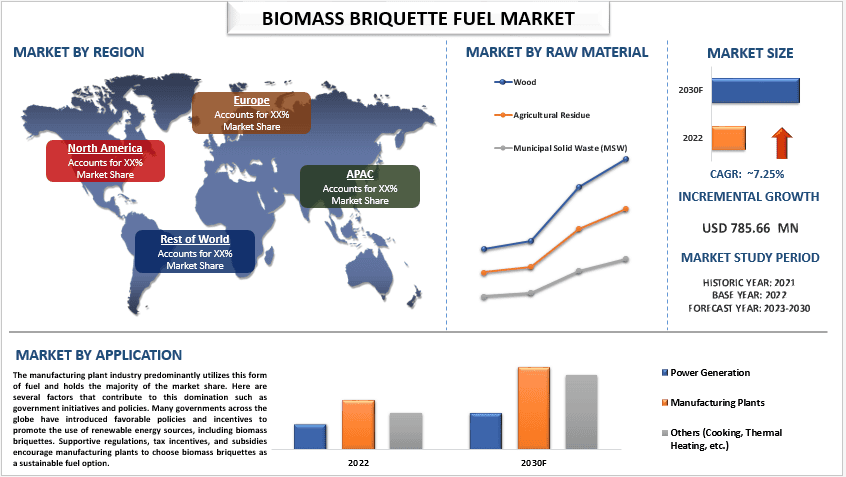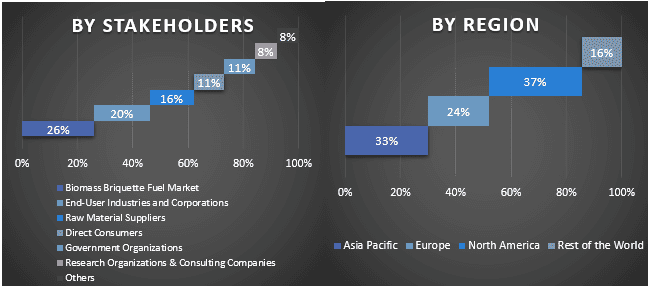- Home
- About Us
- Industry
- Services
- Reading
- Contact Us
Biomass Briquette Fuel Market: Current Analysis and Forecast (2023-2030)
Emphasis on Raw Material (Wood, Agricultural Residue, and Municipal Solid Waste (MSW)), Application (Power Generation, Thermal Energy, and Others (Cooking, Manufacturing Plants, Etc.)); and Region/Country
https://www.exitrealtygulfshores.com/

The Biomass Briquette Fuel Market was valued at 785.66 million in the year 2022 and is expected to grow at a strong rate of around 7.25% during the forecast period (2023-2030), owing to the growing climate change concerns and government targets of the rapid shift from traditional fossil fuels. Furthermore, the escalating concerns surrounding climate change have compelled governments to take aggressive action to reduce carbon emissions. Fossil fuels, such as coal and oil, are major contributors to greenhouse gas emissions, leading to the exacerbation of global warming. The burning of biomass briquettes, on the other hand, has significantly lower carbon emissions, making it an attractive option for policymakers aiming to meet emission reduction targets. For instance, according to the International Energy Agency (IEA), renewable energy sources contributed to an estimated 27% of global electricity generation in 2020, with biomass playing a significant role. Moreover, biomass briquette fuels are derived from organic waste materials such as agricultural residues, wood waste, and forest residues. This renewable energy source offers a sustainable alternative to fossil fuels as it helps reduce dependence on depleting natural resources. Additionally, biomass briquettes contribute to waste management by recycling organic waste that would otherwise end up in landfills, further enhancing their appeal.
Some of the major players operating in the market include Enviva; drax; PFEIFER GROUP; ENERGEX PELLET FUEL, INC.; LIGNETICS GROUP; Georgia Power; Om Greentech Industries; Wismar Pellets GmbH; Balcas; and Viridis Energy Inc. Several M&As along with partnerships have been undertaken by these players to facilitate customers with hi-tech and innovative products/technologies.
Insights Presented in the Report
“Amongst raw materials, the agricultural residue biomass briquette fuel segment held the significant market share in 2022.”
Based on raw materials, the market is segmented into wood, agricultural residue, and municipal solid waste (MSW). Agricultural residue is predominantly used, and holds a significant market share. Several factors contribute to this domination such as an abundance of agricultural residue. Agricultural activities generate significant amounts of residue, such as crop stalks, husks, straw, and bagasse. The availability of these residues in large quantities makes them a readily accessible and cost-effective raw material for biomass briquettes. Furthermore, utilizing agricultural residue for biomass briquette production often creates opportunities for rural communities. Farmers can generate additional income by selling agricultural residues, while local industries can establish briquette manufacturing facilities, leading to employment and economic growth. Moreover, using agricultural residue for briquette production helps address waste management challenges associated with these residues. Instead of burning or discarding them, converting agricultural residues into briquettes provides a sustainable waste management solution, minimizing environmental pollution. These factors collectively contribute to the domination of agricultural residue in the manufacturing of biomass briquettes and its significant market share.
“Amongst application, the Manufacturing Industry held a significant share of the market in 2022.”
Based on application, the market is segmented into power generation, thermal energy, and others (cooking, manufacturing plants, etc.). The manufacturing plant industry predominantly utilizes this form of fuel and holds most of the market share. Here are several factors that contribute to this domination such as government initiatives and policies. Many governments across the globe have introduced favorable policies and incentives to promote the use of renewable energy sources, including biomass briquettes. Supportive regulations, tax incentives, and subsidies encourage manufacturing plants to choose biomass briquettes as a sustainable fuel option. For instance, in 2021, the Ministry of Power of India partnered with the National Thermal Power Corporation (NTPC) and launched a project in Samarth, supporting the use of biomass. Officials from CPCB (Central Pollution Control Board) and PPCB met on 6 October, with CPCB announcing a fund worth USD 6 million to promote the manufacturing of pellets and briquettes. The fund will be distributed across five states but is likely to benefit Punjab due to the volume of crop residue there. Furthermore, as the demand for sustainable and environmentally friendly practices increases, many manufacturing plants, and steel manufacturing plants prioritize their corporate social responsibility goals. By using biomass briquettes as a fuel source, these plants demonstrate their commitment to reducing their carbon footprint and contributing to a greener future.
“Asia Pacific is anticipated to witness a significant growth during the forecast year (2023-2030).”
The Asia Pacific region has rapidly emerged as one of the fastest-growing regions in the biomass briquette fuel market. The increasing awareness of the environmental impacts of conventional fuels along with the region’s abundant biomass resources has led to a surge in demand for alternative and sustainable sources of energy. The Asia Pacific region is blessed with an abundance of biomass resources such as agricultural waste, forest residues, and organic industrial waste. This vast availability of biomass enables the production of biomass briquette fuel at a significantly lower cost compared to other regions. Furthermore, governments across the Asia Pacific region are increasingly implementing policies and incentives to promote the use of renewable energy sources, including biomass briquette fuel. For instance, in India, the Ministry of New and Renewable Energy offers financial incentives and tax benefits to encourage the adoption of biomass-based energy systems. Such supportive policies provide a conducive environment for the growth of the biomass briquette fuel market. Moreover, the rapid industrialization and urbanization in countries like China, India, and Indonesia have significantly contributed to the growth of the biomass briquette fuel market. The rising energy demand in various sectors, including power generation, cement production, and heat applications, has driven the adoption of biomass briquettes as a reliable and sustainable energy source. For instance, in 2020, the Chinese government announced plans to replace coal with biomass briquettes in thousands of industrial boilers, further boosting the market growth.
Biomass Briquette Fuel Market Report Coverage
Report Attribute | Details |
Base year | 2022 |
Forecast period | 2023-2030 |
Growth momentum | Accelerate at a CAGR of 7.25% |
Market size 2022 | USD 785.66 million |
Regional analysis | North America, Europe, APAC, Rest of the World |
Major contributing region | Asia Pacific is expected to witness a significant growth during the forecast period |
Key countries covered | The U.S., Canada, Germany, The U.K., France, Italy, Spain, China, India, Japan |
Companies profiled | Enviva; Drax; PFEIFER GROUP; ENERGEX PELLET FUEL, INC.; LIGNETICS GROUP; Georgia Power; Om Greentech Industries; Wismar Pellets GmbH; Balcas; and Viridis Energy Inc. |
Report Scope | Market Trends, Drivers, and Restraints; Revenue Estimation and Forecast; Segmentation Analysis; Impact of COVID-19; Demand and Supply Side Analysis; Competitive Landscape; Company Profiling |
Segments Covered | By Raw Material; By Application; By Region/Country |
Reasons to buy this report:
- The study includes market sizing and forecasting analysis validated by authenticated key industry experts.
- The report presents a quick review of overall industry performance at one glance.
- The report covers an in-depth analysis of prominent industry peers with a primary focus on key business financials, product portfolios, expansion strategies, and recent developments.
- Detailed examination of drivers, restraints, key trends, and opportunities prevailing in the industry.
- The study comprehensively covers the market across different segments.
- Deep dive regional level analysis of the industry.
Customization Options:
The global biomass briquette fuel market can further be customized as per the requirement or any other market segment. Besides this, UMI understands that you may have your own business needs, hence feel free to contact us to get a report that completely suits your requirements.
Table of Content
Research Methodology for the Biomass Briquette Fuel Market Analysis (2023-2030)
Analyzing the historical market, estimating the current market, and forecasting the future market of the global biomass briquette fuel market were the three major steps undertaken to create and analyze the adoption of biomass briquette fuels in major regions globally. Exhaustive secondary research was conducted to collect the historical market numbers and estimate the current market size. Secondly, to validate these insights, numerous findings and assumptions were taken into consideration. Moreover, exhaustive primary interviews were also conducted, with industry experts across the value chain of the global biomass briquette fuel market. Post assumption and validation of market numbers through primary interviews, we employed a top-down/bottom-up approach to forecasting the complete market size. Thereafter, market breakdown and data triangulation methods were adopted to estimate and analyze the market size of segments and sub-segments of the industry pertains to. Detailed methodology is explained below:
Analysis of Historical Market Size
Step 1: In-Depth Study of Secondary Sources:
A detailed secondary study was conducted to obtain the historical market size of the biomass briquette fuel market through company internal sources such as annual reports & financial statements, performance presentations, press releases, etc., and external sources including journals, news & articles, government publications, competitor publications, sector reports, third-party database, and other credible publications.
Step 2: Market Segmentation:
After obtaining the historical market size of the biomass briquette fuel market, we conducted a detailed secondary analysis to gather historical market insights and share for different segments & sub-segments for major regions. Major segments are included in the report as raw material and application. Further country-level analyses were conducted to evaluate the overall adoption of testing models in that region.
Step 3: Factor Analysis:
After acquiring the historical market size of different segments and sub-segments, we conducted a detailed factor analysis to estimate the current market size of the Biomass Briquette Fuel market. Further, we conducted factor analysis using dependent and independent variables such as the raw material and application of the biomass briquette fuel market. A thorough analysis was conducted for demand and supply-side scenarios considering top partnerships, mergers and acquisitions, business expansion, and product launches in the biomass briquette fuel market sector across the globe.
Current Market Size Estimate & Forecast
Current Market Sizing: Based on actionable insights from the above 3 steps, we arrived at the current market size, key players in the global Biomass Briquette Fuel market, and market shares of the segments. All the required percentage shares split and market breakdowns were determined using the above-mentioned secondary approach and were verified through primary interviews.
Estimation & Forecasting: For market estimation and forecast, weights were assigned to different factors including drivers & trends, restraints, and opportunities available for the stakeholders. After analyzing these factors, relevant forecasting techniques i.e., the top-down/bottom-up approach were applied to arrive at the market forecast for 2030 for different segments and sub-segments across the major markets globally. The research methodology adopted to estimate the market size encompasses:
- The industry’s market size, in terms of revenue (USD) and the adoption rate of the biomass briquette fuel market across the major markets domestically
- All percentage shares, splits, and breakdowns of market segments and sub-segments
- Key players in the global biomass briquette fuel market in terms of products offered. Also, the growth strategies adopted by these players to compete in the fast-growing market.
Market Size and Share Validation
Primary Research: In-depth interviews were conducted with the Key Opinion Leaders (KOLs) including Top Level Executives (CXO/VPs, Sales Head, Marketing Head, Operational Head, Regional Head, Country Head, etc.) across major regions. Primary research findings were then summarized, and statistical analysis was performed to prove the stated hypothesis. Inputs from primary research were consolidated with secondary findings, hence turning information into actionable insights.
Split of Primary Participants in Different Regions

Market Engineering
The data triangulation technique was employed to complete the overall market estimation and to arrive at precise statistical numbers for each segment and sub-segment of the global biomass briquette fuel market. data was split into several segments & sub-segments after studying various parameters and trends in the areas of raw material and application in the global biomass briquette fuel market.
The main objective of the Global Biomass Briquette Fuel Market Study
The current & future market trends of the global biomass briquette fuel market were pinpointed in the study. Investors can gain strategic insights to base their discretion for investments on the qualitative and quantitative analysis performed in the study. Current and future market trends determined the overall attractiveness of the market at a regional level, providing a platform for the industrial participant to exploit the untapped market to benefit from a first-mover advantage. Other quantitative goals of the studies include:
- Analyze the current and forecast market size of the biomass briquette fuel market in terms of value (USD). Also, analyze the current and forecast market size of different segments and sub-segments.
- Segments in the study include areas of raw material and application.
- Define and analyze the regulatory framework for the biomass briquette fuel
- Analyze the value chain involved with the presence of various intermediaries, along with analyzing customer and competitor behaviors of the industry
- Analyze the current and forecast market size of the biomass briquette fuel market for the major region
- Major countries of regions studied in the report include Asia Pacific, Europe, North America, and the Rest of the World
- Company profiles of the biomass briquette fuel market and the growth strategies adopted by the market players to sustain in the fast-growing market
- Deep dive regional level analysis of the industry
Frequently Asked Questions FAQs
Q1: What is the current market size and growth potential of the global Biomass Briquette Fuel market?
Q2: What are the driving factors for the growth of the global Biomass Briquette Fuel Market?
Q3: Which segment has the largest share of the global Biomass Briquette Fuel market by Raw Material?
Q4: What are the emerging technologies and trends in the global Biomass Briquette Fuel market?
Q5: Which region is the fastest growing in the global Biomass Briquette Fuel market?
Q6: Who are the key players in the global Biomass Briquette Fuel market?
Related Reports
Customers who bought this item also bought










